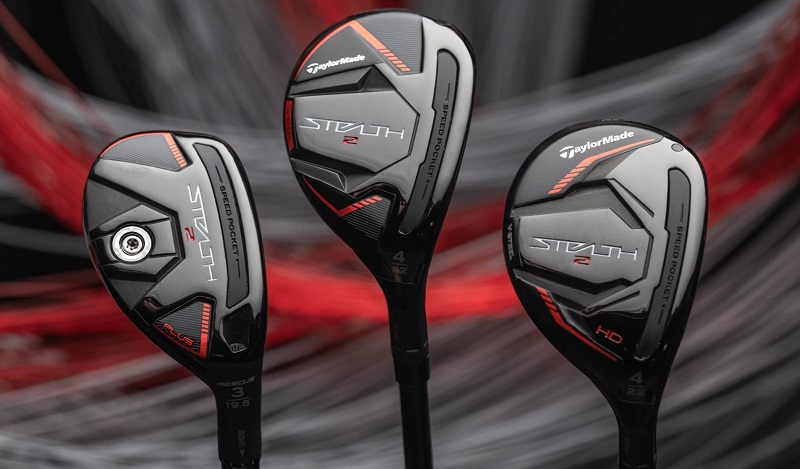Golfers always look for the perfect club to help them hit their shots more accurately and within distance. While there is no such thing as a one-size-fits-all golf club, two clubs that offer great versatility and performance are 2-hybrid and 3-wood clubs.
In this article, we’ll explore the differences between 2-hybrid vs 3-wood golf clubs, discussing their features and benefits and comparing them to help you choose properly. We’ll also discuss scenarios where each club would most effectively improve your game off the tee. So let’s get started!
The 2-Hybrid vs 3-Wood Golf Clubs – Overview
The game of golf has continually evolved over the years thanks to advancements in technology, technique, and equipment. One of the most significant developments has been the introduction of hybrids to complement the traditional wood club options. These hybrids have been specifically designed to combine the best features of long irons and woods, so we often see them replacing their counterparts in golfers’ bags today.
As the golfing world progresses, a constant question arises: Should you opt for a 2-hybrid or a 3-wood club? To make an informed decision, it is crucial to understand the distinctions between these two types of clubs.
A proper evaluation of the advantages and limitations of each club will ultimately aid you in unlocking your full potential on the green.
What Are the Pros and Cons of Using a 2-Hybrid Club?

Pros
A 2-Hybrid club is a highly effective club that assists golfers in easily getting their long shots airborne, providing great distance and accuracy even in challenging conditions.
Moreover, it boasts a touch of finesse as it lands softly on the green, reducing the probability of rolling out and ensuring that golfers get closer to the hole more consistently. In addition, the club’s ingenious design allows it to glide through the turf, maximizing contact with the ball and resulting in a cleaner, more precise shot.
Exploiting the benefits of a 2-Hybrid club and its higher percentage of GIR ensures a professional and superior golfing experience for both amateurs and seasoned players.
Cons
While the 2-hybrid club has gained popularity among golfers for its versatility and forgiveness, it is important to consider some of its disadvantages compared to the traditional 3-wood.
One noticeable drawback is that the 2-hybrid offers less carry, meaning the ball may not travel as far in the air before hitting the ground. This reduces total distance when using the 2-hybrid, as it does not cover as much ground as the 3-wood would for the same swing.
Furthermore, the 2-hybrid tends to have a lower fairway in regulation (FIR) percentage than the average 3-wood, indicating it may not provide the accuracy and control many golfers seek when attempting to hit the fairway.
What Are the Pros and Cons of Using a 3-Wood Club?

Pros
The versatility of this club allows players to achieve longer distances off the deck and tee compared to other options, such as the 2 Hybrid. This adaptability makes it an ideal choice for a wide range of shots on the course.
Furthermore, the 3-Wood club’s propensity for producing a higher fairway in regulation percentage is invaluable for those looking to improve their overall game.
One of the most appealing features of the 3-Wood club is its utility as an excellent alternative to the driver, especially during off days when accuracy with a driver is lacking.
Cons
Although acknowledged as a valuable addition to many golfer’s arsenals, the 3-wood club presents a set of potential drawbacks that could hinder one’s progress on the course.
The club’s design and impact may make it difficult for golfers to achieve optimal loft for their shots, consequently taking longer to get airborne off the deck.
Furthermore, the additional roll often accompanying a 3-wood shot leads to a decreased GIR percentage, potentially compromising a golfer’s overall performance.
Lastly, when faced with the challenge of extricating a ball from the rough, the club’s mechanics make it a less than ideal option.
Due to its inherent design, golfers may struggle with control and risk jeopardizing the success of their stroke.
What Are The Differences Between 2-Hybrid vs 3-Wood Clubs?
The 2-hybrid and 3-wood clubs may look similar at first glance, but there are some significant differences between the two that should be considered when choosing the best option.
Loft Angle
A notable comparison can be made between a standard 2 hybrid and a 3 wood, particularly regarding their loft attributes.
A 2 hybrid typically features a loft angle of 18-22 degrees, which is beneficial for beginners and high handicappers as it simplifies the task of accurately launching the ball.
On the other hand, the 3 wood possesses a lower loft range of 15-18 degrees, with 15 degrees being the most prevalent. Although this lower loft results in a decreased ball flight and increased distance, it also demands a higher level of skill to execute a successful strike.
Shaft Length
The importance of shaft length in determining the distance difference between a 2 hybrid and a 3 wood cannot be understated.
Generally, a 2 hybrid features a shaft length of approximately 41-42 inches, while the 3 wood measures 43 inches. This additional length on the 3 wood contributes to increased clubhead speed and, as a result, greater distance production.
However, golfers must consider that this advantage comes at a cost – the longer shaft inherently makes it more difficult to locate the center of the clubface upon impact consistently.
Distance
Given the discrepancy in loft and shaft characteristics, one should be cognizant of the distance variations between the 3 wood and 2 hybrid clubs.
On average, male golfers can expect a carry distance of approximately 220 yards when utilizing a 3-wood, while a 2-hybrid yields a slightly lower range, closer to 200 yards.
Nonetheless, it is essential to remember that individual experiences may vary, owing to the uniqueness of each golfer’s swing. Consequently, to maximize your potential on the course, it is crucial to comprehend these differences while also considering your specific skillset and swing characteristics.
Clubhead
The size difference between a 3-wood and 2 hybrid clubheads is more than just the numbers. The difference can be seen with the naked eye as modern 3 wood clubheads are significantly larger in size when compared to that of a 2 hybrid.
At 170-190 cc, 3-woods are about 30% larger in size, which directly impacts the difficulty level in hitting off the deck. In contrast to their smaller, 120 cc-sized counterparts, 3-woods almost feel like attempting to hit an old-school driver off the deck.
Well aware of this fact, golfers must take extra precautions in targeting accurate shots while using these longer clubs or else they will face inconsistent results.
Scenarios Where Each Club Would Be Most Effective
The art of golf club selection lies in understanding the unique situations on the course where specific clubs would be most effective in delivering optimal results; the 2-hybrid and 3-wood clubs are no exception.
When facing long par-3s, uphill approaches or challenging lies in the fairway, the versatility and distance offered by a 2-hybrid club cannot be overstated. With its ability to achieve a high trajectory and soft landing, the 2-hybrid becomes an indispensable tool for golfers looking to reach the green or provide a seamless transition from a difficult lie to the safety of the fairway.
On the other hand, the 3-wood club excels in situations requiring a balance of distance, accuracy, and low trajectory, such as off-the-tee shots on narrow par-4s and reaching long par-5s in two.
Golfers who master the strategic use of 2-hybrid and 3-wood clubs can easily navigate the golf course’s intricacies, amplifying their competitive advantage and taking their game to new heights.
Final Thoughts
The differences between a 2-hybrid and a 3-wood golf club are more significant than just the numbers. Each club’s loft angle, shaft length, and head size give golfers distinct advantages and disadvantages, making it essential to select the correct tool for the job.
Golfers must understand their swing characteristics and various course situations to optimize the use of their clubs, ultimately creating a powerful combination that can lead to a successful and enjoyable round of golf.
Combining all these factors can greatly affect one’s ability to improve accuracy and distance off the tee.
With this knowledge, golfers can make a more informed decision about which club suits their game best.
Frequently Asked Questions
Is A 3-Wood Or 2-Hybrid More Forgiving?
Generally speaking, the larger head of a 3 wood is more forgiving than the smaller head of a 2 hybrid.
Is It Better To Use A 3-Wood Or 2-Hybrid Off The Tee?
It depends on the situation. If you want more distance and accuracy, a 3-wood may be best suited for off-the-tee shots. However, if you need a higher trajectory and softer landing, then a 2 hybrid may be the better choice.
What Is The Difference In The Loft Angles Between A 3-Wood And 2-Hybrid?
The usual loft angle for a 3 wood is usually between 15-18 degrees, while a 2 hybrid is typically 18-22 degrees. The higher the loft angle, the higher the trajectory of your shot.
Can A 2 Hybrid Replace My 3 Wood?
It is possible to use a 2 hybrid instead of a 3 wood. However, it’s important to consider your swing characteristics and the course situation to determine which club would be most effective for you.
Is It Easy To Hit A 2 Hybrid Than A 3 Wood?
Generally, it is easier to hit a 2 hybrid than a 3 wood since the smaller head and lower loft angle of the 2 hybrid make it easier for golfers to hit the ball consistently and accurately. The long shaft of a 3 wood makes it more difficult to control the shot when hitting off the deck.



I was suggested this website by way of my cousin. I’m not sure whether or not this submit is written by him as no one else recognise such particular about my trouble. You are amazing! Thank you!